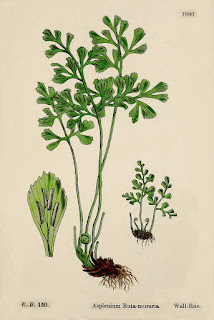Left: Botanical illustration of Asplenium ruta-muraria.
Center and right: Asplenium ruta-muraria on a wall in La Rocca, Bergamo.
Center and right: Asplenium ruta-muraria on a wall in La Rocca, Bergamo.
Today we spent an hour visiting La Rocca – a fortress that is part of Bergamo’s Città Alta. La Rocca fortress is made up of a memorial park and the Casa dei Bombardieri or Bombardier’s School. The park is free to enter and explore, offering 360-degree views and a great view on to Città Alta as La Rocca is at the east edge of the upper city. The school is the main building in La Rocca and contains one of the museums in the family of Bergamo museums called Museo delle Storie di Bergamo, and even better 360-degree views.
The museum inside La Rocca, also called Museo dell’Ottocento, deals with the Risorgimento (Italian Unification) and while it is a difficult museum to get through it is one of the most rewarding for those that persist. Part of the difficulty is the subject matter. The Risorgimento had many players and events that are hard to keep track of. Also, this museum is currently all signed in Italian, and the exhibits are on complex subjects such as the silk economy, an overview of the Fiera (a very important fair that once existed in the lower city), and demographic and economic facts and figures.
Included in the museum entrance fee is access to access to the top of the Casa dei Bombardieri. On the stairs up to the top of the roof, we noticed this fern that looked similar but not exactly the same as the Maidenhair Spleenwort we talked about in the post Asplenium trichomanes – Another Bergamo Wall Plant.
The plant we noticed is in the same genus and is called Asplenium ruta-muraria, commonly known wall rue. First, based on our obsessive analysis of walls in Bergamo, A. ruta-muraria seems to be much less common than A. trichomanes. Second, A. ruta-muraria has green rachises (midribs), not black like A. trichomanes. And, A. ruta-muraria has pinnules that look like small ginkgo leaves or as suggested by the common name, like the leaves of Ruta graveolens, commonly called rue.
Wall rue is a lithophyte, that is, it grows in or on rocks, and grows exclusively on limestone and other calcareous rocks. In Europe and cities like Bergamo, it can be found on masonry works. Wall rue is called ruta di muro in Italian and according to Flora Italiana (one of our go-to sites), it is present all over Italy. Wall rue is present in the Eastern United States as well but is found more in well-weathered limestone outcrops and rarely invading masonry works according to Flora of North America.



Left: The sori (spore structures) of Asplenium ruta-muraria.
Center and right: More examples of A. ruta-muraria on walls in Bergamo.



No comments:
Post a Comment
All comments are moderated. If your comment doesn't appear right away, it was likely accepted. Check back in a day if you asked a question.